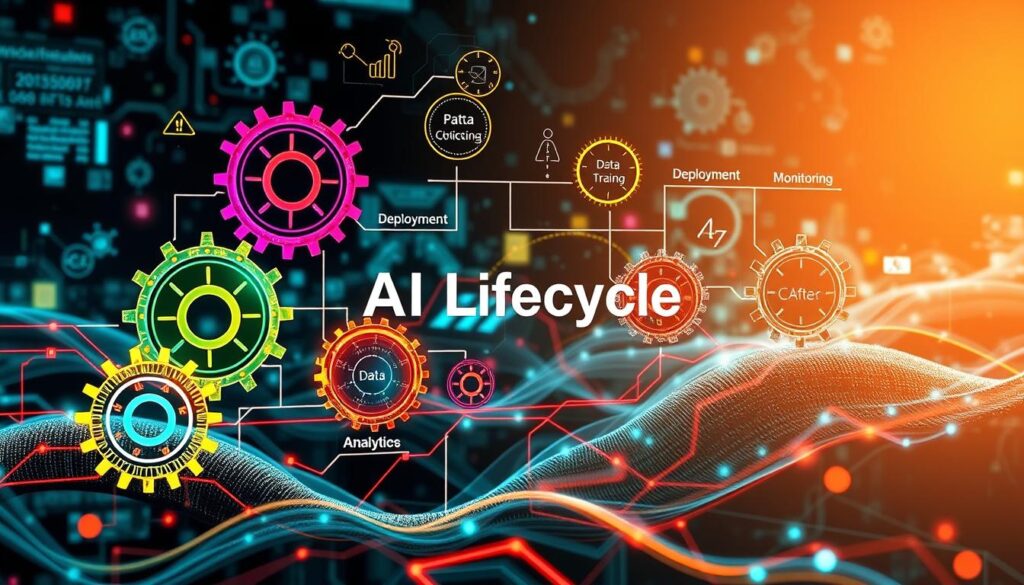Databricks Labs is leading the way in data analytics and machine learning. It offers top-notch tools and resources for AI and ML. These are built on the Apache Spark-based Databricks Unified Analytics Platform. They work well with the Databricks ecosystem, helping with data-driven innovation.
Databricks Labs has tools for the whole AI and ML process. This includes getting data, preparing it, making models, deploying them, and watching how they do. These tools use distributed computing, big data analytics, and cloud computing. They help solve tough problems and make the most of data.
Key Takeaways
- Databricks Labs provides a suite of machine learning tools and resources built on the Databricks Unified Analytics Platform
- These solutions cover the entire AI and ML lifecycle, from data to deployment, empowering organizations to drive data-driven innovation
- Databricks Labs leverages the power of distributed computing, big data analytics, and cloud computing to tackle complex challenges
- The tools seamlessly integrate with the broader Databricks ecosystem, offering a holistic approach to data and machine learning
- Organizations can leverage Databricks Labs to unify their data assets, develop and deploy AI/ML models, and automate workflows throughout the AI lifecycle
Generative AI on Databricks
Databricks leads the generative AI revolution. It offers tools and resources for data pros. You can build, deploy, and monitor AI apps here.
Unity Catalog for Data Governance
The Unity Catalog is key to Databricks’ AI. It manages data, models, and functions. This keeps your AI data safe and secure.
MLflow for Model Development Tracking
MLflow is vital for AI model development. It helps track and version experiments. This makes fine-tuning AI models easier.
Mosaic AI Model Serving for LLM Deployment
Mosaic AI Model Serving deploys AI models. It works with open LLMs and third-party models. This makes serving and monitoring AI models simple.
Databricks has everything you need for generative AI, LLMs, and foundation models. It handles data governance, model development, and deployment. Databricks is your go-to for prompt engineering, retrieval augmented generation, and fine-tuning apps.
Databricks Labs
Databricks Labs is a place for open-source projects and tools. These tools make the Databricks platform better. They help developers, data scientists, and engineers try new things and work faster.
The dbx command-line interface (CLI) tool is a key project. It makes starting and managing Databricks projects easy. This helps users set up and run their apps on Databricks.
| Requirement | Version |
|---|---|
| Minimum Python version | 3.8 or above |
| Minimum dbx version | 0.8.0 |
| Databricks CLI version | 0.18 or below |
To use dbx, you need Python, pip, dbx, and Git. Visual Studio Code, PyCharm, and IntelliJ IDEA are best for working with dbx.
Dbx works well with single-file Python code and compiled Scala and Java JAR files. But it doesn’t support single-file R code files or compiled R code packages with Jobs API 2.0 and 2.1.
Databricks Labs also has the Databricks Labs LSQL project. It’s a lightweight SQL execution library for the Databricks platform. LSQL is great for serverless apps because it executes SQL queries in a stateless way from the Databricks SDK for Python.
“Databricks Labs projects are for your exploration only. They are not formally supported by Databricks with service level agreements (SLAs). They are provided AS IS, and Databricks does not make any guarantees of any kind.”
If you have trouble with Databricks Labs projects, report it as a GitHub Issue. Databricks will look at it, but there’s no formal SLA for support. If you have a Databricks Support Services contract, you can ask for help with these projects.
AI Lifecycle Management with Mosaic AI
Databricks’ Mosaic AI platform manages the whole AI lifecycle. It covers data collection, preparation, model development, deployment, and monitoring. This platform helps teams work together smoothly. It ensures everyone has the same information about data and models.
Data Collection and Preparation
Mosaic AI makes collecting and preparing data easier. It combines data and ML into one place. This way, teams can see how data turns into models, keeping everything clear and traceable.
Model Development and LLMOps
Mosaic AI makes creating and using models simpler. It uses MLflow for tracking model changes. This helps teams work together better and keep track of versions. It also supports large language models (LLMs) for bigger projects.
Serving and Monitoring
Mosaic AI keeps models running well. It has a special feature for managing models. This makes it easy to switch between different models. It also tracks data and model quality, helping find and fix problems.
Mosaic AI puts the whole AI process in one place. It helps Databricks users manage their AI lifecycle better. From data collection to model monitoring, it makes work more efficient and clear.

Machine Learning on Databricks
The Databricks Data Intelligence Platform has many tools for machine learning (ML) and deep learning. It helps with data governance, preparation, model training, serving, and monitoring. This makes it easy for companies to use machine learning on databricks for all their needs.
Tasks and Components
Some important parts of the Databricks Data Intelligence Platform are:
- Unity Catalog helps manage data, features, models, and functions. It also handles discovery, versioning, and lineage.
- Lakehouse Monitoring tracks data changes, quality, and model prediction quality.
- Feature engineering and serving capabilities are also included.
- Databricks AutoML and Databricks notebooks help train models.
- MLflow tracks model development and LLM evaluation.
- Mosaic AI Model Serving serves custom models, including large language models (LLMs) and foundation models.
- Databricks Jobs helps build automated workflows and ETL pipelines.
- Databricks Git integration manages version control of ML and data assets.
These parts work together for a smooth machine learning on databricks experience. They let you focus on creating and deploying ML solutions. You don’t have to worry about the infrastructure and tools.

“Databricks provides a comprehensive platform that simplifies the entire machine learning lifecycle, from data preparation to model deployment and monitoring. The integration of tools like Unity Catalog, Lakehouse Monitoring, and Mosaic AI Model Serving enables us to build and deploy machine learning solutions faster and more efficiently.”
Deep Learning Capabilities
Databricks Runtime for Machine Learning makes setting up deep learning easy. It comes with clusters ready for TensorFlow, PyTorch, and Keras. This means you can start working right away without any hassle.
The platform also has GPU support for faster model training. It comes with drivers and libraries ready to go. Plus, it supports Ray for easier scaling of your work.
Mosaic AI Model Serving makes deploying models simple. It lets you use GPUs without extra setup. This means your models run smoothly and fast.
| Feature | Benefit |
|---|---|
| Databricks Runtime for Machine Learning | Pre-configured clusters with compatible deep learning libraries |
| GPU Support | Accelerate model training and inference with GPU parallelization |
| Mosaic AI Model Serving | Scalable GPU endpoints for deploying deep learning models |
Databricks’ deep learning tools help organizations reach their goals. They use gpu support and parallelization for databricks runtime for machine learning.
Getting Started with AI and ML on Databricks
Databricks has lots of resources and tutorials for AI and machine learning (ML). It’s great for both experienced data scientists and newcomers. You can use Databricks to create and use powerful AI and ML apps.
Start with the Databricks tutorials. They cover many topics, like:
- MLOps workflows on Databricks
- AutoML and feature engineering
- Model serving and Lakehouse Monitoring
- MLflow experiment tracking
The Databricks documentation also has detailed info on Mosaic AI features. You can learn about:
- What is AutoML and how to use it
- Techniques for advanced feature engineering and serving
- Deploying and serving models with Databricks Model Serving
- Monitoring your Databricks Lakehouse for model performance and drift
- Managing the entire machine learning lifecycle with Databricks MLflow
With these resources, you can explore AI and ML on Databricks. You’ll learn to build, deploy, and check your models. Plus, you’ll use the platform’s strong data processing and governance.
| Feature | Description |
|---|---|
| AutoML | Automated machine learning that simplifies model development and selection |
| Feature Engineering | Tools for creating and optimizing features to improve model performance |
| Model Serving | Scalable deployment and serving of models for real-time inference |
| Lakehouse Monitoring | Continuous monitoring of model performance and data drift in the Databricks Lakehouse |
| MLflow | End-to-end machine learning lifecycle management, including experiment tracking and model deployment |
“Databricks makes it easy to get started with AI and ML, providing a wealth of resources and powerful tools to streamline the entire machine learning lifecycle.”
Conclusion
Databricks Labs offers a wide range of tools for AI and data science. It has cutting-edge generative AI and Mosaic AI for managing data. This makes it a complete solution for data experts.
Teams can use the Databricks Data Intelligence Platform to work with their data safely. They can build and use advanced AI models to help their business grow. Databricks Labs helps everyone, from engineers to SQL analysts, work better and smarter.
Databricks keeps up with the changing data world. It gives companies the tools they need to succeed with big data and AI. By using Databricks Labs, businesses can find new chances, work more efficiently, and lead in their fields.
Frequently Asked Questions
What is Mosaic AI and how does it help build AI and ML systems?
Mosaic AI is part of the Databricks Data Intelligence Platform. It helps with the AI lifecycle from start to finish. This includes data collection, model development, and serving.
It has features for generative AI, like Unity Catalog for governance and MLflow for tracking models. Mosaic AI Model Serving deploys LLMs, and Mosaic AI Vector Search is a queryable database.
Lakehouse Monitoring tracks data and model quality. It also has other tools for AI and ML.
What are the key components of the Databricks Data Intelligence Platform?
The main parts are Unity Catalog for data management and Lakehouse Monitoring for tracking. There’s also Databricks AutoML and notebooks for training models.
MLflow tracks model development, and Mosaic AI Model Serving serves custom models. Databricks Jobs build workflows and ETL pipelines. Databricks Git integration is for version control.
How does Databricks Runtime for Machine Learning help with deep learning?
Databricks Runtime for Machine Learning handles infrastructure for deep learning. It has clusters with deep learning libraries like TensorFlow and PyTorch.
It also has GPU support and libraries for scaling ML workflows. This makes deep learning easier.
What resources are available to get started with AI and ML on Databricks?
Databricks offers tutorials on MLOps, AutoML, and more. The Databricks documentation covers Mosaic AI features like AutoML and model serving.
It also talks about managing the model lifecycle and MLflow experiment tracking. These resources help you start with AI and ML on Databricks.
What support is available for Databricks Labs projects?
Databricks Labs projects are for exploration only. They don’t have service level agreements (SLAs). But, if you’re a Databricks customer, you can get help with these projects.
You can submit support tickets for issues with these projects. Databricks will help with problems related to the Databricks Platform Services.
Kuldeep Nirgude is a computer science student with a strong interest in finance and marketing. With a focus on analyzing industry trends, he writes articles that simplify complex concepts and empower readers to make informed decisions. Kuldeep is dedicated to bridging the gap between technology and business, and is committed to staying updated on the latest innovations shaping the economy.
